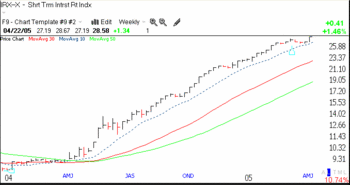Well, the market didn’t collapse today. So what. Did you really think it would just tank like it did in 1987? Most people hope it is over, and think that a further decline is not justified by the state of business, and especially, with all the bargains that have now materialized. However, the market always goes further than everyone thinks is justified–up or down. This bear has plenty of time to smell the roses before it hibernates again. It will take its own time. Especially ominous–the short term interest rate index I follow jumped today–as much as it did when this rise in rates began in the first week of January. Is something going to convince the Fed to become more aggressive? Stay tuned.
Experienced traders do not care which way the market goes, as long as it moves in a trend. Do you really believe the old adage, "Don’t sell America short?" While the market spends most of the time going up, when we can buy stocks, why not profit in those periods of decline, when we can sell stocks short? A good bear lasts 10 or more months and prices decline quicker than they go up–fear is quite a motivator. Why play only one side of the game.
Selling short scares people. You ask your broker to borrow someone elses shares so you can sell them at the current price. He puts the proceeds in your account, but you can’t touch the money until you give back the shares you borrowed. When the stock falls, you buy the shares back at the lower price and give them back to the broker. You, however, get to keep the difference between the price you first sold the shares at and the subsequent buy back price (sell short at 80, buy back at 70–you make $10/share). What scares everyone is the idea that if the stock rises, you have to buy it back at a higher price and the price could theoretically go to a gazillion. However, when you own a stock, the most it can fall is to zero.
Now, this fear of an infinite loss from a short sale is unrealistic. When you buy a stock at, say 50, you place a stop order to automatically sell your shares and "stop your loss" at an acceptable price, say 48. If the stock falls to 48 you get sold out and take your loss. You just reverse this for stocks you have sold short. Sell short at 50, place a stop order to buy if the stock rises to 52. Either way you have a strategy in place to limit your losses. (Note, if the stock gaps up or down–jumps up or down in price and skips over your stop price–you may have a larger loss than your stop order would indicate.)
Now, to sell short I must trade in 100 share blocks in a margin account. Margin, because the broker will charge me interest when he lends me the shares to sell short. But I can’t trade on margin in my IRA account. However, some brokers allow customers to trade options in an IRA. Enter the Put option, IRA.
A put option gives me the right to sell 100 shares to someone at a set price for a set time. Thus, if I think stock XYZ, which is trading at 50 is going to decline, I could purchase a put option to sell 100 shares of XYZ at 50 (or 55, or 60 etc.) good for a few weeks or months. I could then buy the stock, if it declines, to say, 45 and put them to someone at 50. But I do not have to purchase the shares. If XYZ declines, the put option (which trades like a stock on the option exchange) will increase in value and I can sell the option at a profit. But if XYX rises, I can sell the option at a small loss or let it expire worthless. Either way, if the stock rises, the most I can lose is the cost of the option. So much for the myth of the infinite loss from selling short.
I can even buy put options on the stock market indexes (QQQQ, DIA) or ETF’s, if I think we are in a bear market–all in my IRA. I cannot possibly cover all of the ins and outs of options here. I am just trying to whet your appetite and show you how I profit from a declining market. For a primer on options go to the learning center at www.cboe.com. I disregard the media pundits looking for the rare rising stock to purchase and bet on the many stocks that are declining.
